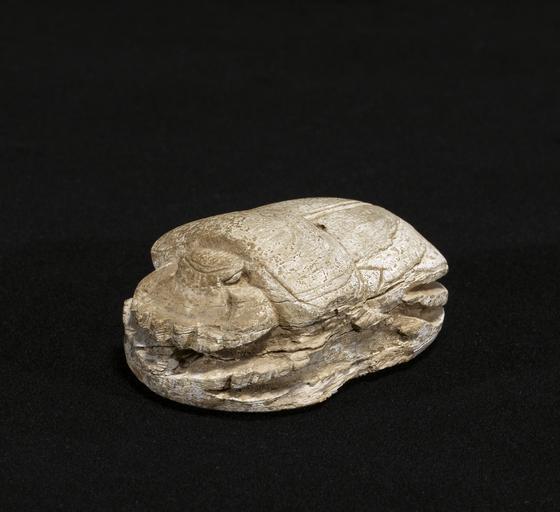MAKE A MEME
View Large Image

| View Original: | Egyptian_-_Commemorative_Scarab_of_Amenhotep_III_-_Walters_42206_-_Three_Quarter.jpg (1800x1645) | |||
| Download: | Original | Medium | Small | Thumb |
| Courtesy of: | commons.wikimedia.org | More Like This | ||
| Keywords: Egyptian - Commemorative Scarab of Amenhotep III - Walters 42206 - Three Quarter.jpg Walters Art Museum artwork en The ancient Egyptians believed that the dung beetle the Scarabaeus sacer was one of the manifestations of the sun god Representations of these beetles were used as amulets and for ritual or administrative purposes This scarab belongs to the so-called group of Commemorative scarabs which were produced in the first years of the reign of king Amenhotep III and his wife Tiye The bottom inscription of the scarab shows ten lines with left reading hieroglyphs nine horizontal text dividers and an oval frame The inscription contains the so-called marriage text It focuses on the divine power and royal authority of the king the legitimate royal status of the queen as well as the royal sphere of control in Egypt and the foreign countries The is precisely written the shapes of the signs simple and clear and executed with thick lines; the layout is well organized but the signs are more narrowly spaced in the upper lines than in the lower ones indicating that the scribe had to stretch the text to the end The highest point of the back is the pronotum dorsal plate of the prothorax Pronotum and elytron wing cases have single borderlines a double line between the wing cases and V-shaped marks for the humeral callosities shoulder thickenings The semicircular head has a double borderline and a short zigzag line at the bottom and the eyes are not marked The side plates are irregularly trapezoidal and the clypeus front plate shows four frontal serrations The proportions of the top are slightly unbalanced and the head sections short in comparison to the large pronotum The raised slender extremities have natural form and vertical hatch notches at the forelegs for the tibial teeth The low oval base is symmetrical The scarab is longitudinally pierced and was mounted or threaded The so-called Commemorative scarabs of Amenhotep III were part of a program of official gifts established in the first eleven years of his reign The texts on the bottom of the large size scarabs glorify the king and queen Tiye and focus on special events There are five different types referring to bull hunt lion hunt sphere of control creation of an artificial lake realization of Maat and diplomatic relations to the Mitanni success foreign policy which were produced in the 2nd 10th and 11th year of the reign of the king All of them mention beside Amenhotep III also his wife Tiye The scarabs were most probably distributed to high officials or special offices in Egypt and abroad This scarab celebrates the divine and royal power of the king his authority and sphere of control as well as the royal status of his wife Tiye The form of scarab elucidates that such a gift had not only a political but also an amuletic function It refers to the stability of royal power by continuous renewal and so far to the reliability of royal patronage for the donee or his office More than 200 examples of these scarabs have been preserved and alone 64 belong to the sphere of control category The astonishing amount of preserved scarabs refers to the enormous output figures and their special importance ca 1380 BC New Kingdom steatite with traces of glaze cm 3 81 5 6 8 5 accession number 42 206 6200 Dikran Kelekian Paris and New York date and mode of acquisition unknown Henry Walters city Baltimore Walters Art Museum Henry Walters Acquired by Henry Walters 1914 Translation Living Horus Strong bull appearing in truth; / He of the Two Goddesses Establishing laws pacifying the / Two Lands; Golden Horus Great of power smiting the Asiatics; King of Upper and Lower Egypt / Neb-Maat-Re; Son of Re Amen-hetep Ruler of Thebes who may receive life The great royal consort / Tiye may she live The name of her father is Yuya / the name of her mother is Tjuia / She is the wife of the militarily powerful king; / the both boundaries of his empire are the southern Kary / and the northern Nah- / arina place of origin Greece Walters Art Museum license Ancient Egyptian scarabs in the Walters Art Museum | ||||